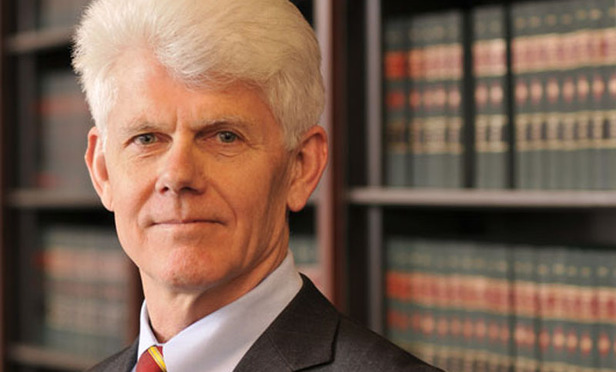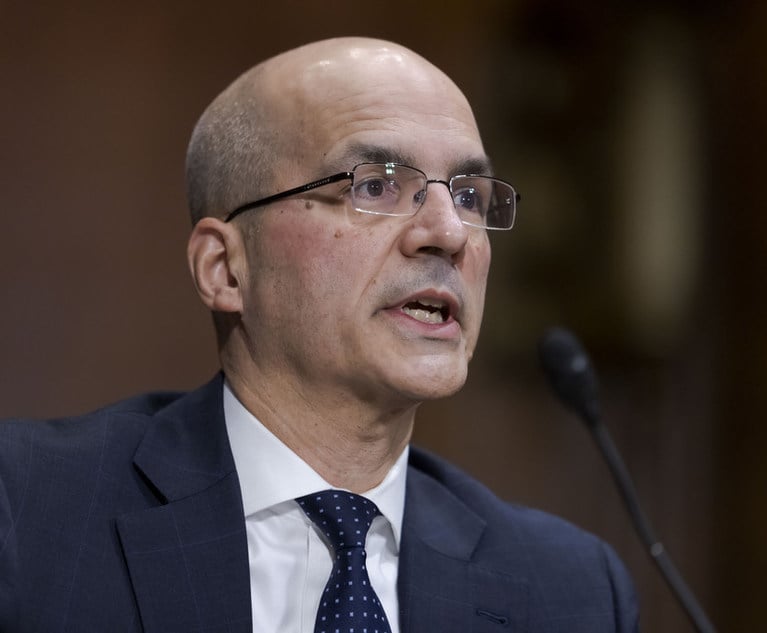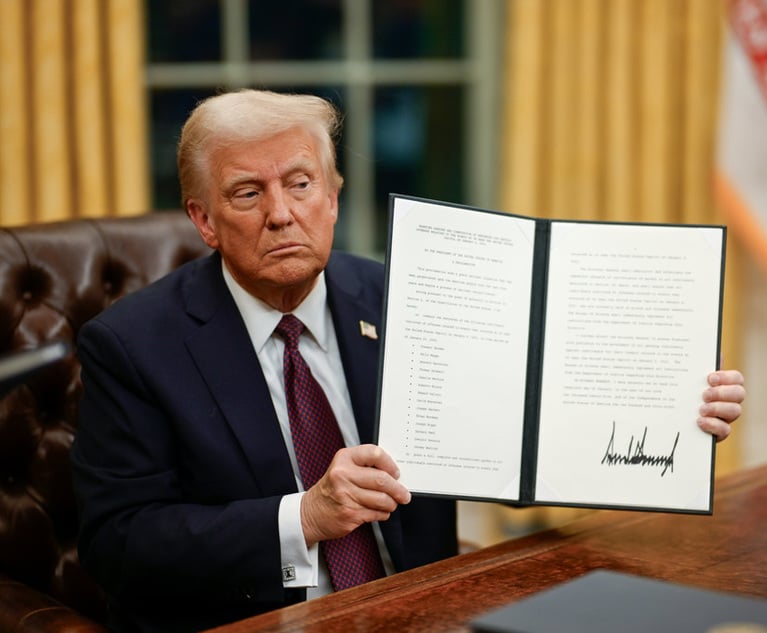Use of Depositions to Meet Plaintiff's Burden of Proof at Trial
Asbestos personal injury claims often are brought many years after the harmful exposure, so it is not surprising that plaintiffs sometimes seek to prove the source of the asbestos through testimony from past cases. CPLR 3117(a)(3) allows use of prior deposition testimony under stated circumstances. In his New York Practice columns, Thomas F. Gleason discusses a recent appeal decided by a divided Third Department in which the majority and dissenters address nuances in such permitted use.
June 14, 2019 at 01:00 PM
8 minute read
 Thomas F. Gleason
Thomas F. Gleason
The mesothelium is a thin layer of tissue covering many organs in the human body, including the lungs. Cancer of that tissue in the lung—mesothelioma—is a particularly deadly and aggressive form of cancer caused by exposure to asbestos. The carcinogenic latent effect of this exposure takes many years to manifest, but CPLR 214-c calculates the commencement of the three-year statute of limitations for claims related to such exposure from the date of the discovery of the cancer, or from when its cause reasonably should have been discovered.
Asbestos personal injury claims often are brought many years after the harmful exposure, so it is not surprising that plaintiffs sometimes seek to prove the source of the asbestos through testimony from past cases. CPLR 3117(a)(3) allows use of prior deposition testimony under stated circumstances, and Billock v. Union Carbide Corporation, 170 A.D.3d 1388 (3d Dep't 2019), is a recent appeal decided by a divided Appellate Division, Third Department in which the majority and dissenters address nuances in such permitted use.
The plaintiff's decedent in Billok was a 42-year-old mesothelioma patient who allegedly was exposed as an infant to joint compound containing asbestos. (Joint compound is the creamy white stuff used to smooth over cracks in sheetrock in the finishing of interior building spaces—it has been very widely used since the demise of wall plaster, and when sanded produces a fine dust that may remain in the building.)
The deceased was diagnosed in 2014 and died only three months later. The joint compound had been manufactured by Georgia-Pacific, and the plaintiff claimed that at the time of the alleged exposure, the joint compound in question contained asbestos supplied by the defendant Union Carbide. As in many asbestos cases, in Billock the central issue was tracing the source of the asbestos.
To do this the plaintiff in Billock sought to use videotaped deposition testimony of a former Georgia-Pacific employee, who had testified as to the ingredients of the joint compound in a 2001 Illinois lawsuit, and in another 2003 case in Texas.
The defendant made a motion in limine in the Supreme Court to preclude such testimony, and in the alternative, if such testimony was to be allowed, to permit the defendant to introduce testimony from a 2007 Texas case, in which the same witness was claimed to have contradicted some of his earlier testimony.
CPLR 3117 provides that “any part or all of a deposition, so far as admissible under the rules of evidence, may be used … by any party for any purpose against any other party who was present or represented at the taking of the deposition or who had notice under these rules.” Subdivision (a)(3) also conditions such use on the unavailability of the witness, whether by death, distance other good reason stated in the statute.
The Supreme Court denied the defendant's motion to preclude the 2001 and 2003 testimony, but granted the defendant's motion to allow the video testimony from 2007. Following a trial in which the jury viewed portions of all three depositions, the jury returned a verdict in defendant's favor. The plaintiff appealed and a divided Third Department reversed.
The problem with the introduction of the 2007 testimony, held the majority opinion by Justice John Egan Jr., was that the plaintiff was not a party to the action in which the testimony was taken, and had no opportunity to cross-examine the witness with respect to the claimed contradiction of the testimony in the prior two cases. The 2007 testimony “pertained directly to the central issue to be resolved by the jury—i.e., whether the joint compound that decedent was exposed to as an infant contained asbestos supplied by defendant.” Therefore, the majority could not say that the admission of such testimony constituted harmless error, so the judgment in favor of the defendant was reversed.
Justice Michael Lynch dissented in an opinion joined by Justice Pritzker, concluding that the introduction of the 2001 and 2003 testimony by the plaintiff made the Georgia-Pacific employee the plaintiff's witness, thus entitling the defendant to use the 2007 testimony for purposes of impeachment. The dissenters recognized that the 2007 testimony could be viewed as hearsay, but found it to bear sufficient indicia of reliability to justify admissibility based on the hearsay exception relating to prior inconsistent statements of a witness.
The dissenters also noted that the witness's testimony had been given under oath and had been subject to cross-examination in a case in which the plaintiff was similarly motivated (as the plaintiff in Billok) to establish the nexus between asbestos and the plaintiff's injury. Accordingly, the dissenters approved of the admission of such testimony into evidence by the trial court “in the interest of justice, and in the interest of fairness.”
Assuming for purposes of discussion that the 2007 testimony truly could be viewed as contradicting the testimony introduced by the plaintiff from the 2001 and 2003 cases (apparently there was some argument over this), one can well understand the fairness argument advanced by the dissenters. Why should the jury not hear the entirety of the witness's prior testimony on the composition of the joint compound, and whether it did contain the defendant's asbestos?
The answer to be derived from the majority opinion appears to be that in addition to the need for an opportunity for cross-examination, CPLR 3117 requires caution in allowing proof that does not come from live witnesses at trial. In addition to rejecting admissibility of the 2007 testimony, the majority expressed its disapproval of the introduction of the 2001 and 2003 testimony, as follows:
“Although a live witness may be impeached with prior inconsistent testimony, [the deposition witness] never testified for any party in this action, either at the trial itself or at any pretrial deposition. He was merely a witness who had testified years ago in multiple other states on the subject of the content of Georgia-Pacific joint compound. Rather than calling him (or any other witness) to testify on this topic, both parties resorted to retrieving video of [his] testimony in those earlier actions and selectively playing those portions they believed supported their respective contentions.”
The majority was troubled by the New York jury being asked to determine whether a witness that had testified, testified more credibly in Illinois or Texas. Referring to the witness as “an empty chair” (a somewhat unflattering appellation), the majority noted that the witness had never testified on behalf of a party in the Billock case, but was merely a witness who had testified in multiple other cases on the subject of the composition of the Georgia-Pacific joint compound. Therefore, the majority held, “CPLR 3117(a)(2) did not permit plaintiff to introduce the 2001 and 2003 depositions on his case-in-chief, and CPLR 3117(c) did not permit defendant to impeach those depositions with another deposition.”
This is a most interesting holding for procedural as well as substantive reasons. It could be argued that the defendant was not aggrieved by the judgment from which the appeal was taken (as the jury had no-caused the plaintiff), but the majority still reviewed the Supreme Court order allowing the 2001 and 2003 testimony on the source of the asbestos, relying on CPLR 5501, which provides an expansive scope of review on an appeal from a final judgment. Review under that section is allowed for: “any nonfinal judgment or order which necessarily affects the final judgment, including any which was adverse to the respondent on appeal from the final judgment and which, if reversed, would entitle the respondent to prevail in whole or in part of that appeal … .”
One might question the applicability of CPLR 5501 to the order allowing the 2001 and 2003 testimony, on the ground that the defendant was going to prevail on the appeal anyway, because of the erroneous admission of the 2007 testimony. However, appellate comment on the admissibility of the 2001 and 20013 testimony seems wholly sensible, due to the importance of such testimony on the retrial. Even as dicta, such guidance for the trial court promoted fairness and judicial economy on the retrial.
On the substantive takeaway from Billock, it is now clear that CPLR 3117(a)(2) requires that a prior deposition must have been taken on behalf of or against a party to the case. It is not enough that the testimony relates to an issue of importance at the trial at which the testimony is sought to be used. Further, it appears that the court will require the nexus between the testimony offered and the issues in the current trial to be strong, especially in situations in which further opportunity for cross-examination might be useful to a party when the deposition is to be used at trial.
Thomas F. Gleason is a member of Gleason, Dunn, Walsh & O'Shea in Albany and an adjunct professor at Albany Law School.
This content has been archived. It is available through our partners, LexisNexis® and Bloomberg Law.
To view this content, please continue to their sites.
Not a Lexis Subscriber?
Subscribe Now
Not a Bloomberg Law Subscriber?
Subscribe Now
NOT FOR REPRINT
© 2025 ALM Global, LLC, All Rights Reserved. Request academic re-use from www.copyright.com. All other uses, submit a request to [email protected]. For more information visit Asset & Logo Licensing.
You Might Like
View All
'A Shock to the System’: Some Government Attorneys Are Forced Out, While Others Weigh Job Options
7 minute read
'Serious Legal Errors'?: Rival League May Appeal Following Dismissal of Soccer Antitrust Case
6 minute read
How Some Elite Law Firms Are Growing Equity Partner Ranks Faster Than Others
4 minute read
Trending Stories
- 1Eliminating Judicial Exceptions: The Promise of the Patent Eligibility Restoration Act
- 2AI in Legal: Disruptive Potential and Practical Realities
- 3One Court’s Opinion on Successfully Bankruptcy Proofing a Borrower
- 4Making the Case for Workflow Automation
- 5Copyright Infringement by Generative AI Tools Under US and UK Law: Common Threads and Contrasting Approaches
Who Got The Work
J. Brugh Lower of Gibbons has entered an appearance for industrial equipment supplier Devco Corporation in a pending trademark infringement lawsuit. The suit, accusing the defendant of selling knock-off Graco products, was filed Dec. 18 in New Jersey District Court by Rivkin Radler on behalf of Graco Inc. and Graco Minnesota. The case, assigned to U.S. District Judge Zahid N. Quraishi, is 3:24-cv-11294, Graco Inc. et al v. Devco Corporation.
Who Got The Work
Rebecca Maller-Stein and Kent A. Yalowitz of Arnold & Porter Kaye Scholer have entered their appearances for Hanaco Venture Capital and its executives, Lior Prosor and David Frankel, in a pending securities lawsuit. The action, filed on Dec. 24 in New York Southern District Court by Zell, Aron & Co. on behalf of Goldeneye Advisors, accuses the defendants of negligently and fraudulently managing the plaintiff's $1 million investment. The case, assigned to U.S. District Judge Vernon S. Broderick, is 1:24-cv-09918, Goldeneye Advisors, LLC v. Hanaco Venture Capital, Ltd. et al.
Who Got The Work
Attorneys from A&O Shearman has stepped in as defense counsel for Toronto-Dominion Bank and other defendants in a pending securities class action. The suit, filed Dec. 11 in New York Southern District Court by Bleichmar Fonti & Auld, accuses the defendants of concealing the bank's 'pervasive' deficiencies in regards to its compliance with the Bank Secrecy Act and the quality of its anti-money laundering controls. The case, assigned to U.S. District Judge Arun Subramanian, is 1:24-cv-09445, Gonzalez v. The Toronto-Dominion Bank et al.
Who Got The Work
Crown Castle International, a Pennsylvania company providing shared communications infrastructure, has turned to Luke D. Wolf of Gordon Rees Scully Mansukhani to fend off a pending breach-of-contract lawsuit. The court action, filed Nov. 25 in Michigan Eastern District Court by Hooper Hathaway PC on behalf of The Town Residences LLC, accuses Crown Castle of failing to transfer approximately $30,000 in utility payments from T-Mobile in breach of a roof-top lease and assignment agreement. The case, assigned to U.S. District Judge Susan K. Declercq, is 2:24-cv-13131, The Town Residences LLC v. T-Mobile US, Inc. et al.
Who Got The Work
Wilfred P. Coronato and Daniel M. Schwartz of McCarter & English have stepped in as defense counsel to Electrolux Home Products Inc. in a pending product liability lawsuit. The court action, filed Nov. 26 in New York Eastern District Court by Poulos Lopiccolo PC and Nagel Rice LLP on behalf of David Stern, alleges that the defendant's refrigerators’ drawers and shelving repeatedly break and fall apart within months after purchase. The case, assigned to U.S. District Judge Joan M. Azrack, is 2:24-cv-08204, Stern v. Electrolux Home Products, Inc.
Featured Firms
Law Offices of Gary Martin Hays & Associates, P.C.
(470) 294-1674
Law Offices of Mark E. Salomone
(857) 444-6468
Smith & Hassler
(713) 739-1250






